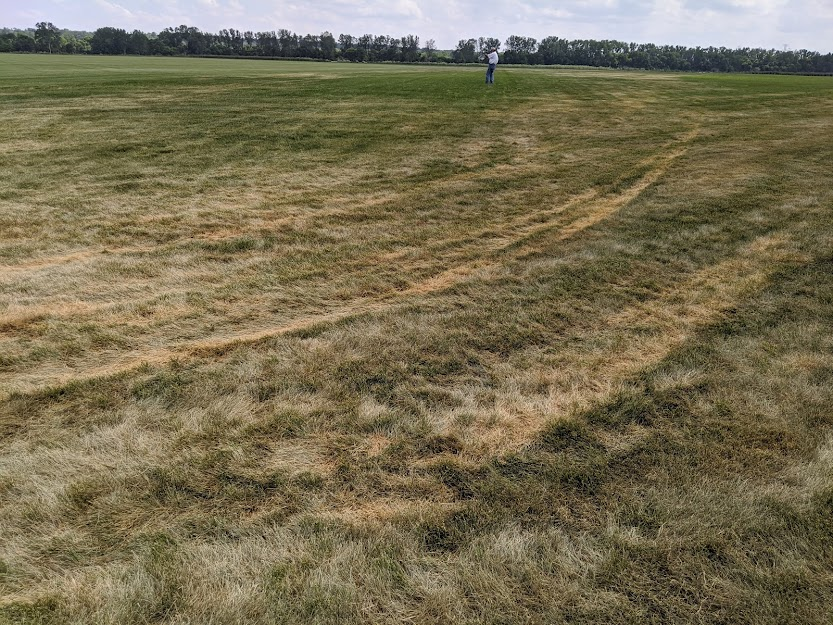Some observations I have noticed in areas I have been looking at include heavy anthracnose on maples and ash, which is particularly an issue associated with wet cool springs. Also, many areas are seeing bumper crops of yellow nutsedge, especially where wetter conditions have prevailed. Meanwhile, large swaths of the country are experiencing prolonged and severe drought stress. Areas of extended drought could easily lead to turf loss, particularly where cool-season turfgrass species are being grown. Many warm-season species can survive longer periods of low moisture and still maintain their green color. Also, the effects of drought stress on trees and landscape ornamentals can sometimes be detected two to three years following a particularly difficult dry cycle. They become more susceptible to insect and disease pressures in this weakened state. The effects of long-term drought patterns can be devastating, so preparation is key. If you are currently experiencing these conditions, there are a few things to keep in mind.
Water is necessary for photosynthesis (the function of the plant to make its own food). When this resource lacks carbohydrate production, photosynthesis slows or stops altogether. Water is also used to dissolve and transport minerals throughout the vascular system. Water is typically lost through transpiration from the leaves through the stomates or pore-like structures, which creates a draw or transpirational pull of moisture and nutrients from the soil. Early in the onset of drought stress, the stomatal openings are shut to reduce water loss, cutting off the natural flow from the soil through the plant. Insufficient water can also decrease the plant’s ability to cool itself, which will further compound the stress complex.
As plants enter dormancy, the leafy shoots will turn brown and crispy, and in many cases, they may die back. Roots will also shrink or die back depending on the length and severity of the dry period. Once more conducive temperatures and available rainfall or irrigation are applied or have resumed, these structures will grow back, provided the crown is kept alive.
Pro Tip: Dormancy of grasses is a function of protection to safeguard the plant; however, some water should still be applied. If dormant grasses endure extended periods without water, the crown could become dehydrated, which will spell death for the plant. Therefore, dormant cool-season grasses should still be irrigated with up to ½ inches of water every two to three weeks to maintain crown hydration and stave off costly lawn renovations. It is also not a good idea to add enough supplemental irrigation to try to reverse dormancy; this situation may require the plant to use excessive reserves, which may weaken it down the road.
Pro Tip: Traditional irrigation systems meant to maintain turfgrasses do not adequately or properly irrigate trees and sometimes ornamental landscape plants. Particularly sensitive trees or woody plants may require extra attention. Pull a hose out to those plants and allow it to trickle for 20 to 30 minutes in several spots to give these larger plants a good supply of water. If the drought period becomes excessive, repeating this process is a good idea.
There are some other keys to success during these dry stretches:
- Raise mowing heights and keep blades sharp before the onset of stress.
- Suspend mowing operations as drought progresses. Often, they are not needed and may do more damage than good.
- Limit or postpone herbicide applications. Weeds are also not actively growing, so control will not be good, and some products may compound issues on stressed turf.
- Hold off on fertility programs, as they can result in damage or loss of product.
- Limit usage and disperse traffic.

As mentioned earlier, preventative measures are much more effective than curative ones. The problem comes in weather predictions; it may be tough to foresee what Mother Nature has in store for your region. If the turf does succumb or large areas do not resume growth, renovation or reseeding will be required. Consider selecting a more drought-tolerant species. For instance, turf-type tall fescues or TTTF tend to be much more drought tolerant because of the depth at which their root system will grow; this gives the plant more soil volume with which it can mine moisture. Perennial ryegrass roots do not grow as deep, and Kentucky bluegrasses even shallower. Pay closer attention to those A-List qualified like King Tall Fescue and Ace Perennial Ryegrass. This standard means that these particular varieties require fewer inputs like water and fertilizer and are more tolerant of heat and adverse conditions.
Additional drought management tools need to be considered, such as reducing compaction and thatch to allow better water infiltration. Applying fertilizers with potassium (K) or the third number of the fertilizer analysis will help with water regulation and stress tolerance. The use of wetting agents can help with water efficiency. These products improve the penetration of rainfall or irrigation into the soil and allow the water to spread for more even wetting. Hydretain is a water conservation technology that can be used on turf and ornamentals. It will help them survive nearly twice as long without water and can help reduce irrigation requirements by about 50% for up to 3 months on one application.
Several EMPRO-branded products also help manage stress prior to difficult periods, including EMPRO Kelp Complex, which helps mitigate stress and build strong root systems; Aer8tion, which helps develop denser roots and stronger plants; and granular products like the EMPRO Soil Enhancer, which creates more water-holding capacity and pore space in the soil.
Whatever the case or approach, drought is best managed preventatively. The cost of water, lost plant material, or customers far outweighs the upfront costs of precautionary measures.
Lean on Us for Turf & Ornamental Solutions
Contact Ewing’s Turf Tech Team, for more information on grub control and other turf questions. Email me at klewis@ewingos.com or call/text 480-669-8791. We’re happy to help.





